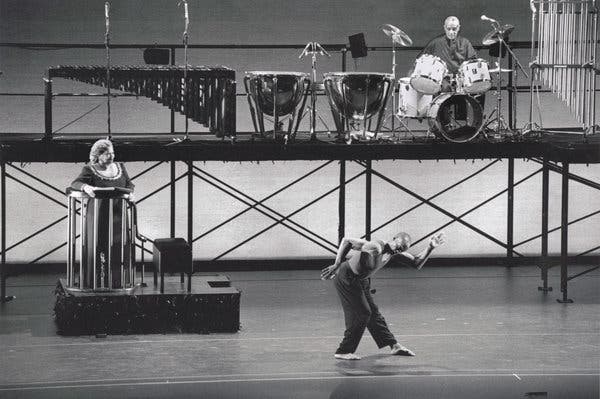There’s an image that will stay with me forever: Toni Morrison, Bill T. Jones and Max Roach were all onstage together. Toni Morrison read her beautiful text, Max Roach was at the drums and Bill T. Jones was dancing. And at the end of the evening, Jones took Morrison in his arms and waltzed across the stage. I have spent the better part of today searching for that picture, the one of Toni Morrison dancing. There are several photos here from that performance, but the image of the curtain-call waltz may exist only in my memory of the evening.

CreditJack Vartoogian for The New York Times
The three artists had collaborated on a piece called “Degga” for the Lincoln Center Serious Fun festival. It was a fitting title because that evening, pictured here, was seriously fun. The year was 1995, and as The Times noted, “This was an evening spent with three icons of American culture, who hold among them two MacArthur grants, a Pulitzer and a Nobel Prize.” The writer, Jennifer Dunning, went on to note, “Luckily, the three are also artists of irresistible vitality, whose intensity as performers made for theater that was a voyage of discovery.”
Irresistible vitality and intensity were cornerstones of Morrison’s extraordinary life. She wrote some of the finest novels in the English language. Yes. She was the first and remains the only African-American woman to win a Nobel Prize. Yes. But she also wrote plays: “Desdemona” and “Dreaming Emmett.” She wrote the libretto for the opera “Margaret Garner,” which traced the life of the woman who inspired her masterpiece, “Beloved.” She wrote essays and picture books. In 2008, she was even nominated for a Grammy Award for Best Spoken Word Album for Children for her performance of a picture book she wrote with her son Slade, “Who’s Got Game?”
The earliest photos of Morrison here aren’t of her as the vaunted author but of her as editor. She was an editor at Random House who thought in 1970 that Muhammad Ali, still on the outs with the United States government over his draft status, should write an autobiography. She also worked closely with Angela Davis — recently acquitted of murder, kidnapping and conspiracy charges — to do the same.
Jill Krementz photographed her during these early years, when Morrison was a single mother of two young sons, who got up early to write before going into her publishing job. In these photos, you see her writing on the couch in her living room, you see her embracing her son. From the beginning, she never strived to be mysterious, as so many authors do. The photographs confirm what those of us who spent any time with her knew, she was gregarious and honest. She always let the world in — especially women and people of color.
[Read Toni Morrison’s New York Times obituary.]
In a 1977 interview with The New York Times Book Review she talked about how she juggled motherhood, her job at Random House and a part-time job teaching fiction at Yale. “It does seem hectic,” she said. “But the important thing is that I don’t do anything else. I avoid the social life normally associated with publishing. I don’t go to the cocktail parties. I don’t give or go to dinner parties. I need that time in the evening because I can do a tremendous amount of work then.”
She went on to explain that at 46, and after the success of her first three books — “The Bluest Eye,” “Sula” and “Song of Solomon” — she was at long last finding the financial freedom to devote more of her time to writing. “I’ve always thought about writing full time, but there was so much insecurity about not having a job,” she said. “I wanted to make a big score first.”
The photos here can be viewed in some way as a travelogue, images along the path that was the big score of Morrison’s legacy. She did not do cocktail parties, but she made time for a party in celebration of her winning the Nobel Prize. You can see her here, joyful and in her element, at Maya Angelou’s home, with Oprah Winfrey; Susan L. Taylor, the longtime editor of Essence magazine; and Angela Davis. This photo captures “black girl magic” incarnate: There is so much beauty, so much power, so much excellence and activism and joy.
There came a point in Morrison’s life when her very portrait became a kind of shorthand for literary gravitas. With her silver locks, she was, in her last decades, a lioness of letters. Images of her remind me of the Zora Neale Hurston quote: “I love myself when I am laughing. And then again when I am looking mean and impressive.” Morrison could do serious like nobody’s business, but she had the best laugh, the biggest smile. Her voice remained until the end, a seductive Marilyn Monroe-esque whisper. That comes through in the photos too, how her beauty had complexity. The books she wrote are an indisputable bounty, but the photos of her are their own kind of gift: a reminder that her life was a dance, a voyage of discovery, decades in the making.







